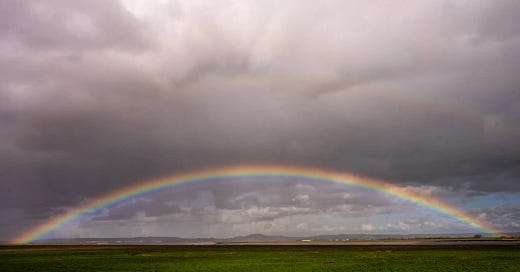Nature's ROI: What a Salt Marsh Can Teach Business Leaders About Smart Climate Solutions
Economics is the key to any climate project's long-term sustainability
Sometimes, “radical technology innovation” can be as simple as letting nature return and do its thing.
The New York Times has a great story this morning about how a small corner of Southwestern England was returned to salt marsh, protecting the surrounding countryside from flooding. It’s a great read—even just for the photos!
It’s working too. From the article:
In September, a month’s rain fell in a single day in some parts of England. The 18 months to March 2024 were England’s wettest in recorded history. Even on an island that has built at least part of its identity around tolerating inclement weather, it has been impossible to ignore the deluge. Flooding has submerged fields, ruined homes, and at times, cut off whole villages.
….The marsh acts as a natural and hugely effective bulwark against flooding, absorbing and slowing tides before they can encroach inland. Even last winter — the wettest anyone in the area could remember — the village at one edge of the peninsula did not flood.
Oftentimes, natural solutions beat the best of our technology.
What’s key in this implementation, though, is how everyone benefits economically—not just environmentally. And it’s not just through flood avoidance (which is obviously the biggest benefit).
Consider:
Local businesses benefit from increased tourism from birders, paddlers and hikers
Local farmers’ cattle can graze the marsh, both improving the marsh (through weed and grass control) and the beef (a free-range, varied diet yields better meat)
The article notes that the marsh project is so popular, there’s now a waiting list for local citizens who want to volunteer to help trim hedges, clear paths and otherwise maintain it.
The result?
Local support ensures that the marsh will continue to exist, regardless of what government is in power or what’s trendy & popular. It’s not just a “feel good” project—it’s a new economic engine for the region.
Carbon Leads the Way?
The article mentions the other climate tie-in too—in addition to helping control flooding, the marsh is a carbon sink, capturing approximately 19 tonnes per hectare annually. That’s a secondary benefit to this specific flood-control project, but a benefit nonetheless.
Consider though that that’s in Southwestern England, which lacks the climate to grow species that are particularly good at carbon sequestration. A tropical mangrove forest, for example, can capture 10x more carbon per hectare than a temperate terrestrial marsh, like those in England.
But even in England, there’s a very real carbon impact.
Business Impact
What should a business leader draw from a project like this?
First, your firm could be part of a project like this, directly benefiting your local community (and customers) and playing a role in your overall climate innovation strategy. If you’re with a large corporation, your firm could partner with a developer to sponsor an entire project.
Any sized firm, however, can support a project like this by purchasing the carbon-removal credits generated by the project’s carbon sequestration activities. It’s an easy, direct way to play a role in bringing projects like this to life.
More broadly though, successful projects like this are great analogies to how your team should think about climate opportunities for your business. The success of this project depended on it being more than a ‘climate feel-goody project’: It’s success is that it directly benefited the local population through flood control and economic benefits. This isn’t a hand-holding, feel-good moment—it’s a serious response to a serious challenge, with serious benefits for all stakeholders.
Similarly, any successful climate innovation project in your organization must be more than a feel-good story for marketing. It must directly improve the well-being of your business, either by reducing costs, opening up new markets, or (ideally) both.
Your business exists to make money—any sustainable climate project must support that mission.
***
There are hundreds of climate projects—big and small—that have addressed climate concerns while benefiting the local economy. Do you have a favorite? Drop it in the comments or let me know!




